How to tie knots for fishing: step by step guide
For fastening hooks on the line, binding leashes and so on. E. There are many different types of knots. And the ability to knit their strong fishing is essential, especially for fishermen who are just beginning this wonderful process.
Why do we need a strong and durable components for fishing?
The existing large firms directories that make fishing gear, reside new, exceptional strength in knots. They lead to a reduction in strength Leskov veins, which in turn reduces its strength when angling, and increases the likelihood of rupture of fishing tackle (almost 2 times).
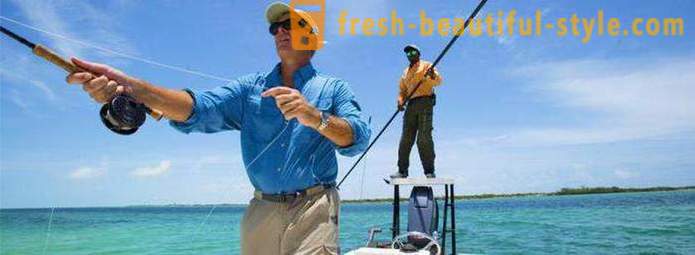
It is therefore necessary ability to tie knots, which are less traumatized thread.
Types of fishing knots
They can be divided according to the place and purpose of knitting:
1. To attach the bait and hooks:
• "Clinch" (Clinch Knot fishing) - a single, double, superior.
• "Palomar" (Palomar) - double, triple.
• "Bottom".
• Non-Slip Loop.
2. To attach the woods and cords:
• "Blood".
• Double Uni Knot.
• "Albright".
• "Surgical".
Clinch (Clinch Knot fishing)
In the method of knitting "clinch" a few species. Simple (Normal) "clinch" is used where there is no need special strength. For example, the slip on the leash for cargo. In case holds it better to tear in order to avoid breaking the entire gear. Knitting Algorithm cord is threaded through the eye of the tip; obvorachivaetsya 3-5 times; It is inserted into a loop, but pre-wetted and delayed. Excess cord is cut. "Double clinch" - is strong enough, it is used for strings.
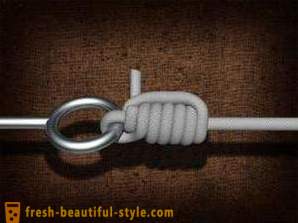
"Superior clinch" is used to monolesok. He is one of the most used for attaching lures, hooks, etc. Binding sites for fishing on the type of improved clinch quite simple:. Through the eye of the lure is pulled free end of the fishing line, the last five times wrap around the main fishing line. Further, this same end is rotated back through the loop which is formed, and extends between the pigtail and the resulting scaffold. Then, all carefully shrinks down and extra ends are removed.
In addition to the advantages of strength, it is necessary to note the presence of the negative aspects:
• Do not use it in the fishing line from Ø 0, 4 mm. With a diameter larger than this is not possible sufficiently strong tightening, which in turn will lead to the loss of bait and a trophy.
• Do not use it for braided cords with a smooth surface layer: at the time of load slip knot.
Palomar ( "Palomar")
This is a very reliable and lightweight units for fishing, which are applied to all woods, especially for braided cords.
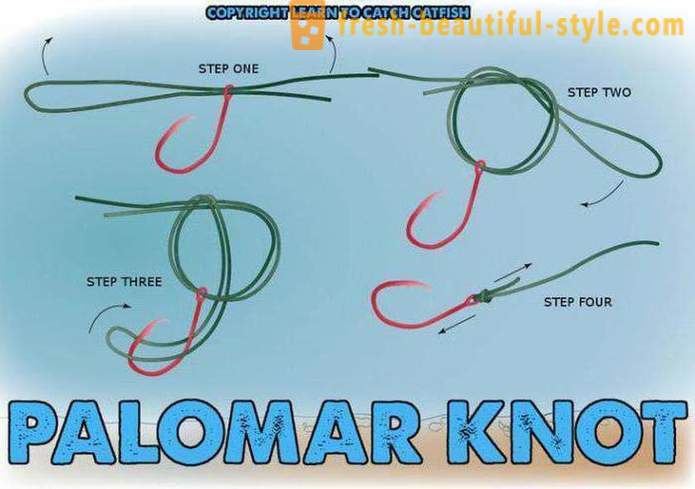
He applied for accession to the line of hooks that have rather big ear or groovy ring, as well as for joining jig-heads and other baits.
knitting process very easy: free tip must be folded in half and pull it through the eye of the hook, the resulting loop through further stretch hook (rotorseal, bait) and pre-wetted pull node.
For braided fishing line (especially on a slippery surface) particularly suited to "dual Palomar". A "triple Palomar" bind spinners, jig-head sinker trough.
"Bottom" (Uni)
This is one of the strongest knots for attaching hooks and baits, and for the most part the woods and cords. In addition to this, Uni - it's a great replacement "clinch", because it is completely no disadvantages of the latter:
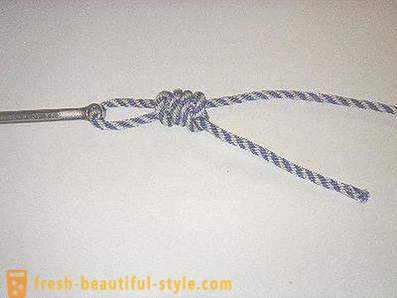
- stretching the free end of the fishing line through the ring Kryuchkov, the latter is pressed against the main fishing line
- retained a small piece of double-scaffold, rotated the free end of the hook to the ring and made 6-7 turns around double the fishing line, and then pulled through a loop.
- is contracted by soaked down in advance the node.
Non-Slip Loop
When it is necessary to give the bait an extra liberty, this node is most useful. It will provide a fixed loop that allows the lure to spin easily, in contrast to the "uni" and "clinch".

knitting algorithm: it is necessary on a small distance from the end of the fishing line loop vyvyazat small size, then stretch the loose end through the fixing of bait and the resulting loop previously. Next, five or six times to wrap around the main fishing line through the loop and pull. Node delayed, but pre-wetted.
It should be clarified that the Non-Slip Loop serves a wonderful replacement for popular among anglers Rapala node, but it is not inferior in reliability and is much easier to fit, which requires an active fishing. Fishing knots Non-Slip Loop popular among anglers who already have some experience.
"Blood" (Blood knot)
He is also known as "snake", acting as representatives of a strong fishing knots. Found application where it is necessary to attach to each other two of line, but preserve their strength properties. In fly fishing, it is used for the purpose of tying the leash with a small diameter of the fishing line, which is then attached to the fly.
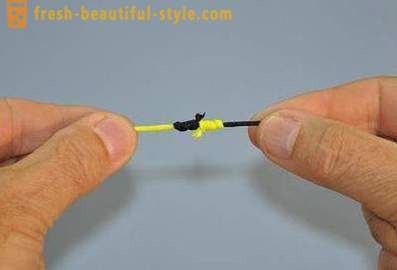
The main negative point "bloody" site yavlyaetya difficulty of knitting, so inexperienced angler takes practice and endurance.
In order for it to knit, to fold the free ends of a length of about six to eight centimeters. Then one end of the fishing line obvorachivaetsya (4-6 times) the other end of the description returns back and is threaded into a previously formed loop in the early wound.
Tightened knots by pulling the loose ends of the fishing line, the extra length is cut off. We should not forget the pre-wet the material.
A further advantage of the described node: its binding via allowed scaffold with different diameters. However, it should remember: the smaller the diameter of a lead with respect to the diameter of the main fishing line, the worse the characteristic of the node. The maximum diameter ratio of linking the woods should be two. For example, when the fishing line attached to Ø 0, 2 and 0, 4, whereas the strength characteristics of the largest node. Ø In the case of 1, 0 and 0, 2, then there is a huge probability that the node will not be secure. However, if such an option is urgently needed, it relies too thin fishing line to connect the two.
Double Uni Knot
It belongs to one of the best sites for fishing. Because with a simple knitting it can master and the novice angler. Characterized by the features fly fishing. leashes for nodes Double Uni Knot ubiquitous among anglers fishing at this (when tying thin flyuorokarbonovogo leash to the cord with a thick diameter) and in any other, when you want to combine two of fishing line.
For this purpose it is necessary to fold line and the free ends of the cord together. Then wrap the cord three times a bound free end of the fishing line, and then they are tightened. And then repeated the same procedure with a cord. At the end of turn 2 knots: on the line and on the cord. And at the end of the procedure must be pulled in opposite directions, and the line cord. Since fixed node. The excess length removed.
"Albright" (Albright knot)
Purpose - binding grove with a difference in diameter of more than one third, and for the connection of the undergrowth and fly line. These nodes Fishing - complex but highly durable, compact and easy to pass through udilischnoe ring.
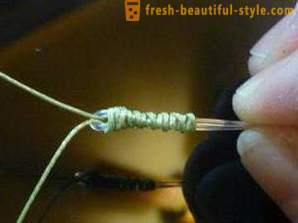
knitting Algorithm form of a thick fishing line loop about ten centimeters, pinch with your fingers at the base. Second stretch thin fishing line through the loop. Thin fishing line wrap around tabs and formed to form the. The working end of the second scaffold leave long twelve or fifteen centimeters. Next, the loop clamp fingers thin (at the top) and thick (at the base). The end of the fishing line wrap thick thin loop and an upper part of the small loop. Make ten or twelve turns, and stretch through the thick end of the loop. Make a last smaller pulling on the free end. Wet assembly and gently pull it over the tip of a thin fishing line. Take hold of each line and gently pulling in different directions, to form a knot. Trim the ends of the length to 1, 5-2 mm.
"Surgery" (Surgeon's Knot)
These nodes for fishing also are one of the simplest. They are used to bind the two ends of the fishing line (including different diameter and material). They are durable in almost one hundred percent.
They are characterized by a negative point: the main purpose of them - it is binding leash and the main fishing line or string. The length of the leash should not be large. Because it requires a bound end obkrutit around the loop gain, and in the case of the long end of the probability of entanglement throughout the gear.
How to fit the surgical site for fishing: the free ends of the main line and leash are attached to each other. Then, from the short end of the main fishing line and tied the leash you need to create a loop, the last few times folded together swing the line, and leash. knot strength depends on the number of revolutions. However, with the addition of speed increases the size of the site (especially when the thick fishing line). It is therefore recommended to make no more than two or three revolutions.













































